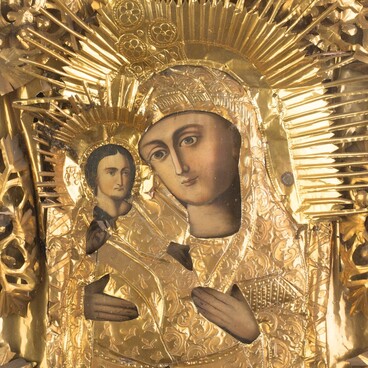The icon of the Savior in a wooden kiot (case) with a revetment made of foil presented in the exhibition is an example of the work of Borisovka icon painters — lichkuns.
Local icon painters appeared in Borisovka no later than the second half of the 18th century. There were few colorists who were able to paint a complete image, but the number of so-called lichkuns, who only painted faces, hands and feet, was constantly growing.
The early 20th-century works of Vasily Timofeyevich Georgievsky mention that the local icon painters worked in small studios for 16–18 hours a day (from 3 to 4 in the morning until 8 to 9 in the evening), with breaks only for food, sleep, holidays and Sundays. There was no division of labor. During the day, a lichkun painted three to five images of one saint; it took up to three days to create a multi-figure composition. They based their works on iconographic examples from lists of saints, Chetyi-Minei (monthly hagiographies of saints), iconographic manuals, and copies of famous icons.
Usually, the icon boards used by lichkuns were not polished or gridded; they were primed using a knife only in the areas where the image was to be painted. The outlines of the face and hands were made with dark brown paints; oil paints were traditionally used; finished works were covered with drying oil. Inscriptions were often made by other masters who knew how to read and write. Artisans tried to hide all these shortcomings under revetments made of foil, glass beads and paper flowers. The nuns of the nearby Tikhvin, Borisovsky, Kursky and Sevsky convents, as well as peasant craftswomen from Borisovka were engaged in this craft.
Most often they painted the iconographic type Christ Pantocrator and the Mother of God (often together as an icon for blessing the young couple), St. Nicholas the Wonderworker, the defender “from hunger and pestilence” St. Charalampos, and the patron saint of cattle St. Blaise.
Borisovka icons were cheap and sold in large quantities in Kursk, Kharkiv, Poltava, Taganrog, Yekaterinoslav, Rostov, Kuban, Don, Azov and even in the Caucasus. In 1901, the Committee of the Guardianship of Russian Icon Painting sent three prominent specialists in the field of ancient Russian art — Sergey Dmitrievich Sheremetev, Nikodim Pavlovich Kondakov and Vasily Timofeyevich Georgievsky — to study iconography in various regions. Having studied samples of Borisovka icons at a Kyiv fair, Kondakov noted that “it was possible to see to what extent icon-painting skills of Borisovka artisans deteriorated, ” hence he deemed earlier monuments to be of better quality.
Local icon painters appeared in Borisovka no later than the second half of the 18th century. There were few colorists who were able to paint a complete image, but the number of so-called lichkuns, who only painted faces, hands and feet, was constantly growing.
The early 20th-century works of Vasily Timofeyevich Georgievsky mention that the local icon painters worked in small studios for 16–18 hours a day (from 3 to 4 in the morning until 8 to 9 in the evening), with breaks only for food, sleep, holidays and Sundays. There was no division of labor. During the day, a lichkun painted three to five images of one saint; it took up to three days to create a multi-figure composition. They based their works on iconographic examples from lists of saints, Chetyi-Minei (monthly hagiographies of saints), iconographic manuals, and copies of famous icons.
Usually, the icon boards used by lichkuns were not polished or gridded; they were primed using a knife only in the areas where the image was to be painted. The outlines of the face and hands were made with dark brown paints; oil paints were traditionally used; finished works were covered with drying oil. Inscriptions were often made by other masters who knew how to read and write. Artisans tried to hide all these shortcomings under revetments made of foil, glass beads and paper flowers. The nuns of the nearby Tikhvin, Borisovsky, Kursky and Sevsky convents, as well as peasant craftswomen from Borisovka were engaged in this craft.
Most often they painted the iconographic type Christ Pantocrator and the Mother of God (often together as an icon for blessing the young couple), St. Nicholas the Wonderworker, the defender “from hunger and pestilence” St. Charalampos, and the patron saint of cattle St. Blaise.
Borisovka icons were cheap and sold in large quantities in Kursk, Kharkiv, Poltava, Taganrog, Yekaterinoslav, Rostov, Kuban, Don, Azov and even in the Caucasus. In 1901, the Committee of the Guardianship of Russian Icon Painting sent three prominent specialists in the field of ancient Russian art — Sergey Dmitrievich Sheremetev, Nikodim Pavlovich Kondakov and Vasily Timofeyevich Georgievsky — to study iconography in various regions. Having studied samples of Borisovka icons at a Kyiv fair, Kondakov noted that “it was possible to see to what extent icon-painting skills of Borisovka artisans deteriorated, ” hence he deemed earlier monuments to be of better quality.

